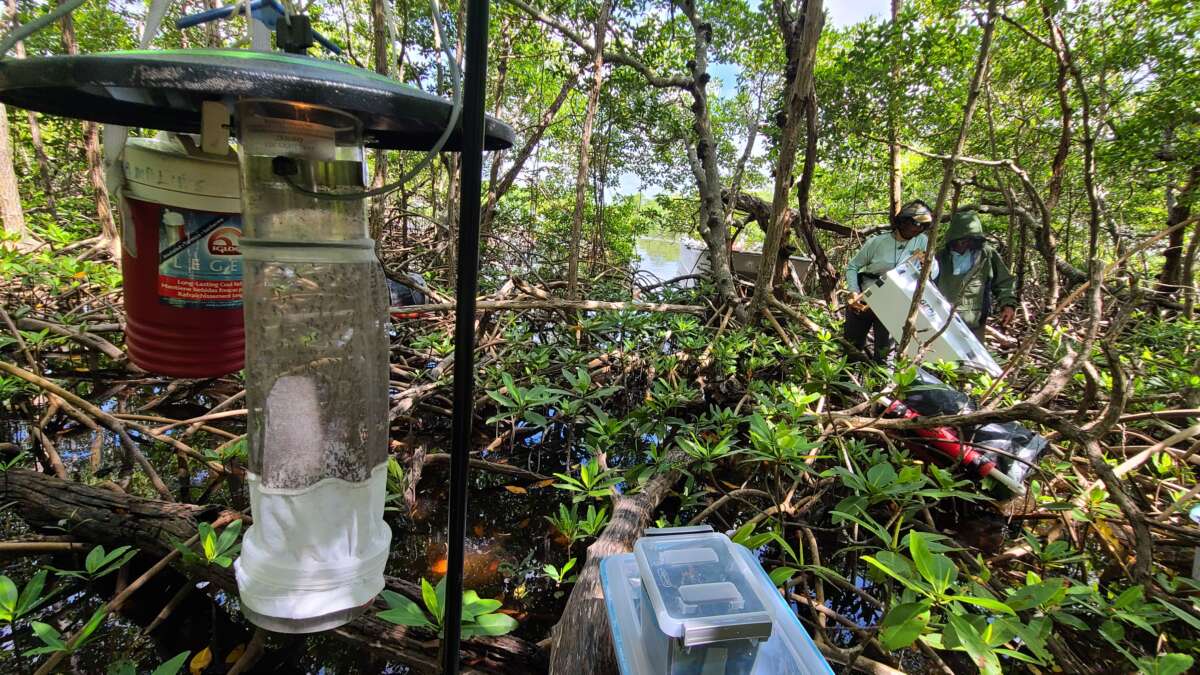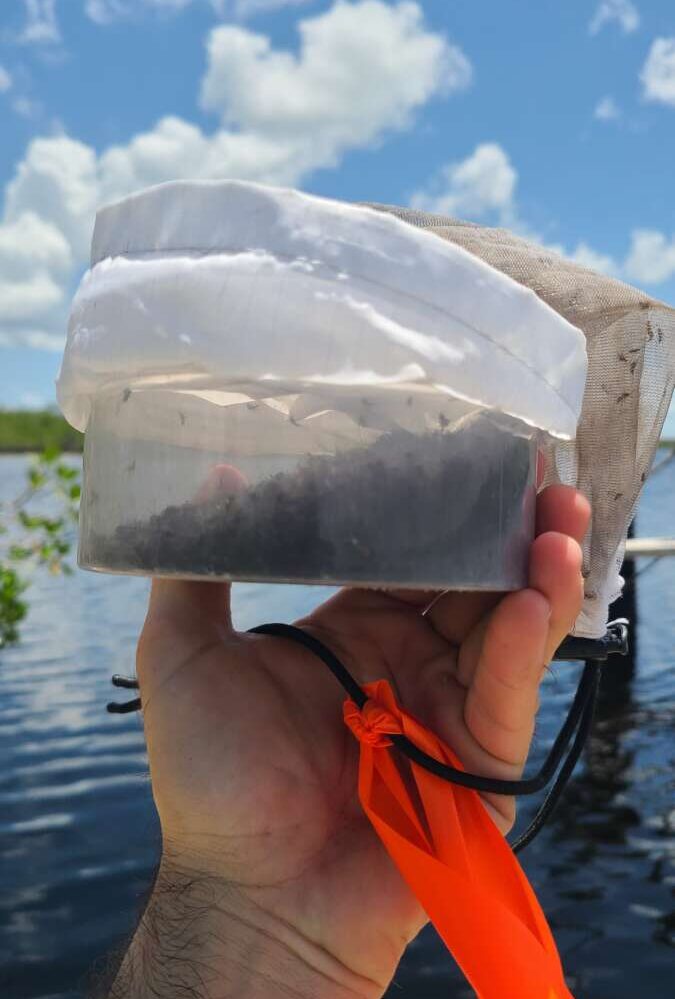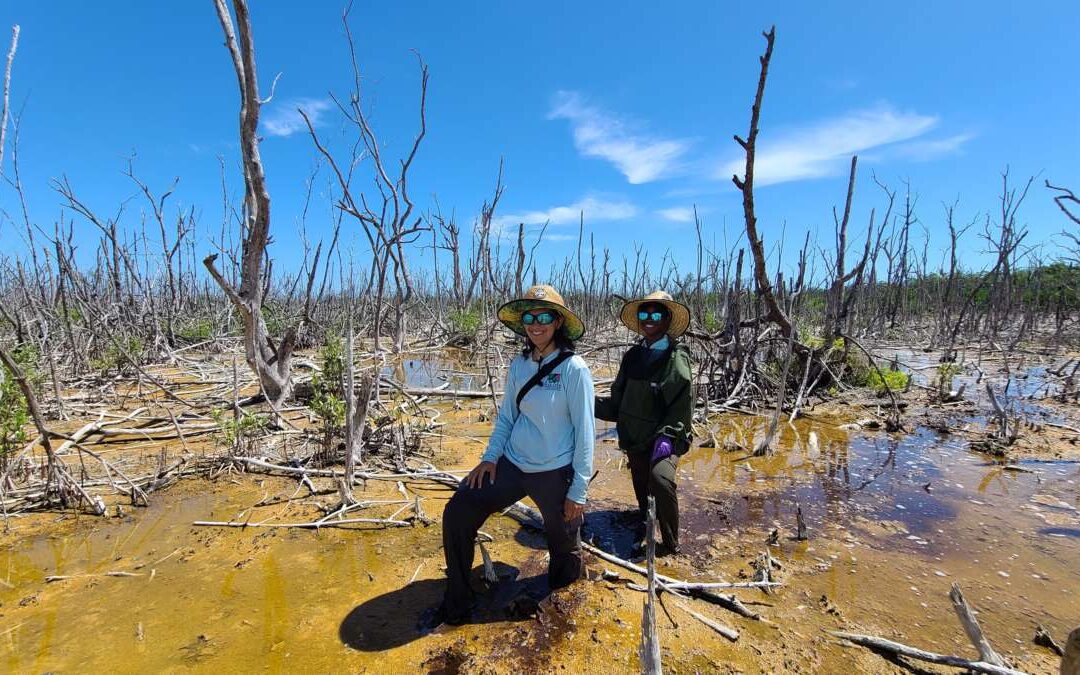How did Kinsey Blumenthal (left in top photo), an Integrated Coastal Sciences (ICS) Ph.D. student, end up studying blood-borne pathogens carried by mosquitos in the Florida Everglades? The story is not as straightforward as one might think.
In short, it took years for all of Blumenthal’s unique interests to align. She has long held an interest in public health. Medicine and infectious diseases intrigued her as she grew up, yet she knew medical school was not for her. While pursuing her undergraduate degree, she also took an interest in remote sensing via an archaeology course. Then in grad school, her work focused on wetlands. When the opportunity came for Blumenthal to enroll in the ICS program, she knew she wanted to combine her passion for wetlands- in this case, mangroves- with that of remote sensing, and working with her now mentor Dr. David Lagomasino seemed like the perfect fit.
“I was drawn to the ICS program because of its interdisciplinary nature. Additionally, Dr. Lagomasino really encouraged me to develop my own project, not limited to the work I was doing for my assistantship,” Blumenthal recalls. “I truly felt like I had ownership over my research as it developed.”
While taking the required courses and electives needed for ICS credits, Blumenthal participated in a mosquito-focused lab led by Dr. Stephanie Richards. Upon completion, she realized she could make a connection between all her main interests for her dissertation.
Fast forward to Summer 2024, and Blumenthal found herself on a two-week trip collecting mosquitoes in the Florida Everglades alongside Dr. Lagomasino and fellow student Daystar Babanawo (right in top photo) for her research.

“My dissertation topic is on identifying how environmental change in mangroves impacts mosquito biodiversity and blood-feeding behavior. The focus is on mosquito species known to transmit disease and the implications of these shifts in mosquito ecology on disease exposure risk,” Blumenthal explains.
While deep in the Everglades, the group of three captured thousands upon thousands of mosquitos from 15 sites using two different collection techniques depending on their intended targets. “Blood fed” mosquitos were generally found resting, as they usually tend to do for several days after feeding. Traps for blood-fed mosquitos consisted of a large diameter aspirator- essentially a crude, portable vacuum (seen in photo background, right)- to pluck the critters from their environment.
Traps for mosquitos seeking a blood meal, on the other hand, were a bit more complex (seen in above photo foreground, left). These more active mosquitos were drawn in using CDC light traps- a hanging trap with a small light positioned over a fan that sucked the mosquitos into a collection bag underneath. While the light attracted many of the mosquitos to the trap, the researchers also added dry ice to the traps as extra bait. Mosquitos rely on chemical signals when looking for their next blood meal, and the off-gassed CO2 from the dry ice mimicked the exhalation of animals targeted as prey.
After two weeks of diligent work and grueling Florida heat, Blumenthal and her colleagues made their way back to North Carolina, and she began to analyze their collections. First order of business? Identify each individual mosquito down to its species, or even sub-species when possible. Once all mosquitos are identified, Blumenthal will run a series of statistical analyses that will hopefully give insight into mosquito biodiversity and spatial patterns in South Florida.

As part of her analysis, and with the help of tools like GIS- a remote sensing, mapping platform- she will compare the current community makeup to that which was identified in a previous study over a decade ago to assess what, if any, changes have occurred in the community makeup of mosquitos in the Everglades. Further insights from this part of her research might include considerations for shifting disease vectors and transmission, and how those two things may be influenced by climate change, as well as water restoration projects in Florida.
Though this most recent field campaign was largely a success, Blumenthal has her work cut out for her. In addition to the mosquito analysis, she must incorporate a social science aspect into her dissertation as required by the ICS program. As such, she is conducting an electronic survey through October of people who regularly work in the mangroves to learn more about their mosquito-related experiences and what preventative measures they might use to guard themselves from the insects.
All in all, Blumenthal believes she has another 12-15 months of research ahead of her but is quite content with the niche project she’s created for herself- one that leaves her at the intersection of remote sensing, wetlands, and human health.
Mosquito Trivia… Did you know?
• Not all kinds of mosquitos transmit diseases. Only a small number of over 3,000 species have been identified as disease vectors.
• Only female mosquitos take blood meals. The nutrients found in blood are necessary for producing eggs.
The preceding story first appeared in the Fall 2024 edition of CoastLines. The fieldwork mentioned in the story was made possible by a 2023 ForEverglades research enhancement grant from the Everglades Foundation to support Blumenthal’s work.



 Based at the Coastal Studies Institute (CSI), the North Carolina Renewable Ocean Energy Program (NCROEP) advances inter-disciplinary marine energy solutions across UNC System partner colleges of engineering at NC State University, UNC Charlotte, and NC A&T University. Click on the links below for more information.
Based at the Coastal Studies Institute (CSI), the North Carolina Renewable Ocean Energy Program (NCROEP) advances inter-disciplinary marine energy solutions across UNC System partner colleges of engineering at NC State University, UNC Charlotte, and NC A&T University. Click on the links below for more information. ECU's Integrated Coastal Programs (ECU ICP) is a leader in coastal and marine research, education, and engagement. ECU ICP includes the Coastal Studies Institute, ECU's Department of Coastal Studies, and ECU Diving and Water Safety.
ECU's Integrated Coastal Programs (ECU ICP) is a leader in coastal and marine research, education, and engagement. ECU ICP includes the Coastal Studies Institute, ECU's Department of Coastal Studies, and ECU Diving and Water Safety. The ECU Outer Banks campus is home to the Coastal Studies Institute.
The ECU Outer Banks campus is home to the Coastal Studies Institute.

